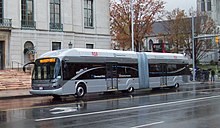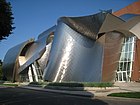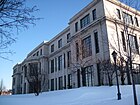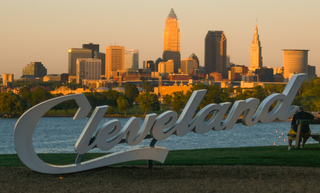
Cleveland, officially the City of Cleveland, is a city in the U.S. state of Ohio and the county seat of Cuyahoga County. Located in Northeast Ohio along the southern shore of Lake Erie, it is situated across the U.S. maritime border with Canada and lies approximately 60 miles (97 km) west of Pennsylvania. Cleveland ranks as the most populous city on Lake Erie, the second-most populous city in Ohio, and the 54th-most populous city in the U.S. with a 2020 population of 372,624. The city anchors the Cleveland metropolitan area, the 33rd-largest in the U.S. at 2.18 million residents, as well as the larger Cleveland–Akron–Canton combined statistical area, the most populous in Ohio and the 17th-largest in the country with a population of 3.63 million in 2020.

Cuyahoga County is a large urban county located in the northeastern part of the U.S. state of Ohio. The county seat and largest city is Cleveland. As of the 2020 census, its population was 1,264,817, making it the second-most populous county in the state.

East Cleveland is a city in Cuyahoga County, Ohio, United States. The population was 13,792 at the 2020 census. It is a suburb lying east and south of Cleveland and west of Cleveland Heights.

Case Western Reserve University (CWRU) is a private research university in Cleveland, Ohio. Case Western Reserve was established after Western Reserve University—which was founded in 1826 and named for its location in the Connecticut Western Reserve—and Case Institute of Technology—which was founded in 1880 through the endowment of Leonard Case Jr.—formally federated in 1967.

The Cleveland metropolitan area, or Greater Cleveland as it is more commonly known, is the metropolitan area surrounding the city of Cleveland in Northeast Ohio, United States. According to the 2020 census results, the six-county Cleveland, OH Metropolitan Statistical Area (MSA) consists of Cuyahoga County, Ashtabula County, Geauga County, Lake County, Lorain County, and Medina County, and has a population of 2,185,825, making it the 33rd-most populous metropolitan area in the United States and the third largest metropolitan area in Ohio. The metro area is also part of the larger Cleveland–Akron–Canton Combined Statistical Area with a population of over 3.7 million people, the most populous statistical area in Ohio and the 17th most populous in the United States.
Peter Benjamin Lewis was an American businessman who was the chairman of Progressive Insurance Company.
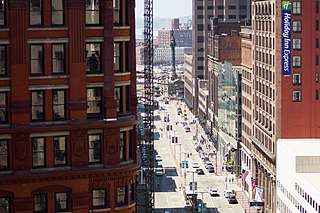
Euclid Avenue is a major street in Cleveland, Ohio, United States. It runs northeasterly from Public Square in Downtown Cleveland, passing Playhouse Square and Cleveland State University, to University Circle, the Cleveland Clinic, Severance Hall, Case Western Reserve University's Maltz Performing Arts Center, Case Western Reserve University and University Hospitals Case Medical Center. The street runs through the suburbs of East Cleveland, Euclid, and Wickliffe, to Willoughby as a part of U.S. Route 20 and U.S. Route 6. The HealthLine bus rapid transit line runs in designated bus lanes in the median of Euclid Avenue from Public Square to Louis Stokes Station at Windermere in East Cleveland.

University Hospitals Cleveland Medical Center (UH Cleveland Medical Center) is a large not-for-profit academic medical complex in Cleveland, Ohio, United States. University Hospitals Cleveland Medical Center is an affiliate hospital of Case Western Reserve University and Northeast Ohio Medical University.

The Cleveland Institute of Art, previously Cleveland School of Art, is a private college focused on art and design and located in Cleveland, Ohio.

Downtown Cleveland is the central business district of Cleveland, Ohio, United States. The economic and cultural center of the city and the Cleveland metropolitan area, it is Cleveland's oldest district, with its Public Square laid out by city founder General Moses Cleaveland in 1796.
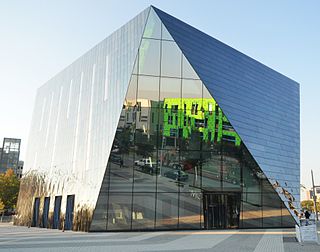
The Museum of Contemporary Art Cleveland is a contemporary art museum in Cleveland, Ohio, United States. It is the only contemporary art venue of its kind in Metropolitan Cleveland. The organisation was founded by Marjorie Talalay, Agnes Gund, and Nina Castelli Sundell in 1968 and has undergone several name and venue changes in the years following its 1968 founding. Originally known as The New Gallery, the museum was rebranded as the Cleveland Centre for Contemporary Art in 1984. The gallery has operated under its current branding as the Museum of Contemporary Art Cleveland (moCa) since 2002.

Cleveland Clinic Hillcrest Hospital is a comprehensive-care hospital on Mayfield Road in Mayfield Heights, Ohio, United States. It is part of the Cleveland Clinic Health System. The hospital currently has 500 registered beds, and serves as a level II trauma center for eastern Cuyahoga, Geauga, Lake, and Portage counties.

Euclid–East 120th was a station on the RTA Red Line in the University Circle neighborhood of Cleveland, Ohio. It was located at the Euclid Avenue and Coltman Road intersection, near the western end of Lake View Cemetery. At the end of service on August 11, 2015, it became the first, and thus far only, station in the history of the RTA to permanently close.

The HealthLine is a bus rapid transit (BRT) line run by the Greater Cleveland Regional Transit Authority in Cleveland and East Cleveland, Ohio, United States. The line runs along Euclid Avenue from Public Square in downtown Cleveland to the Louis Stokes Station at Windermere in East Cleveland. It began operation on October 24, 2008. Its current name was the result of a naming rights deal with the Cleveland Clinic and University Hospitals of Cleveland. The HealthLine is denoted with a silver color and abbreviated simply as HL on most RTA publications.
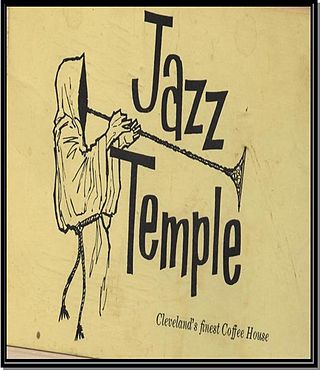
The Jazz Temple was a coffeehouse/nightclub located in the University Circle area of Cleveland, Ohio. The club's name was chosen by the owner, Winston E. Willis, to symbolize a devout gathering place dedicated to the icons of the jazz world where these artists would be collectively enjoyed and appreciated. During its brief history, with frequent headlining appearances by jazz greats such as Miles Davis, John Coltrane, Herbie Hancock, Dizzy Gillespie, and Cannonball Adderley among others, the popular nightspot was more successful than any other similar venue in the region.

East 105th Street and Euclid Avenue was at one time the most famous intersection in the city of Cleveland, Ohio. The legendary commercial junction consists of several blocks from East to West between 107th Street and 105th Street.

Hough is a neighborhood situated on the East Side of Cleveland, Ohio. Roughly two square miles, the neighborhood is bounded to Superior and Euclid Avenue between East 55th and East 105th streets. Placed between Downtown Cleveland and University Circle, Hough borders Fairfax and Cedar–Central to the South and Glenville and St. Clair–Superior to the North. The neighborhood became a target for revitalization during the mid-20th century, after the 1966 Hough Riots.

The demographics of Cleveland have fluctuated throughout the city's history. From its founding in 1796, Cleveland's population grew to 261,353 by 1890, and to 796,841 by 1920, making it the fifth largest city in the United States at the time. By 1930, the population rose to 900,429 and, after World War II, it reached 914,808. Due to various historical factors including deindustrialization, suburbanization, and urban sprawl, Cleveland's population began decreasing in the 1960s. By 1970, the city's population was 750,903. By 1980, it was 573,822 and it had lost its position as one of the top 10 largest cities in the U.S. By 2020, the population had further fallen to 372,624. Beginning in 2018, the city's population began to flatten, after decades of decline. Additionally, between 2010 and 2020, several neighborhoods within Cleveland saw a significant population increase, most notably Downtown, but also University Circle and several West Side neighborhoods.

The Jewish community of the Greater Cleveland area comprises a significant ethnoreligious population of the U.S. State of Ohio. It began in 1839 by immigrants from Bavaria and its size has significantly grown in the decades since then. In the early 21st century, Ohio's census data reported over 150,000 Jews, with the Cleveland area being home to more than 50% of this population. As of 2018, Greater Cleveland is the 23rd largest Jewish community in the United States. As of 2023, the Cleveland Jewish Community is estimated to be about 100,000 people.
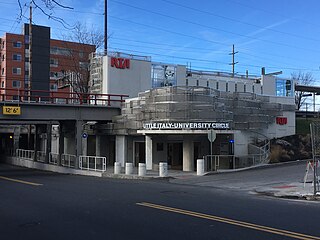
Little Italy–University Circle station is a station on the RTA Red Line in the University Circle neighborhood of Cleveland, Ohio. It is located at the Mayfield Road and East 119 Street intersection, near the western end of Little Italy.


